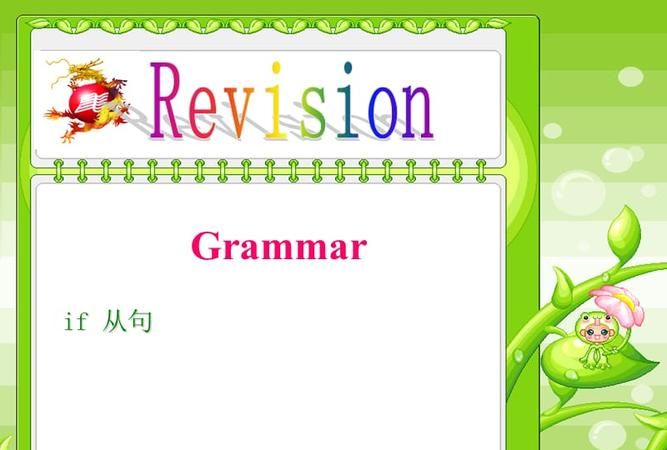本文目录
定语从句趣味公开课
定语从句公开课教案 篇1
Teaching Aims:(教学目的)
1、初步了解定语从句的概念、结构。
2、初步学习并掌握定语从句的规则,尤其是关系代词『who,which,that以及whose』的用法。
Teaching Points:(教学重点)
1.定语从句三要素及关系词的选用
2.只能that或which的情况;
Teaching Methods:(教学方法)
1、举例讲解,说明定语从句的用法。
2、以讲练结合的方法加深学生印象。
Teaching Steps:(教学步骤)
Step1.导入
一、定语及定语从句的概念:
a beautiful girl a handsome boy a clever child
1、 定语是用来修饰名次或代词的。
This is the boy who is clever.
2、定语从句(Attributive Clauses)定义:在主从复合句中修饰名词或代词的从句 定语从句的特点:
定语从句
的引导词关系代词where (地点状语)关系副词
when (时间状语)
why (原因状语)
Step2:详细讲解定语从句语法知识
1、who和whom指人,在从句中分别做主语和宾语,做宾语时可被省略。
the handsome
the tall
the strong boy The boy is Tom.
the clever
the naughty
The boy is Tom.
2、which指物,在从句中做主语或宾语,做宾语时可被省略。
3、that既可指人也可指物,在从句中做主语或宾语,做宾语时可被省略。
4、whose作定语,用来表示先行词和从句主语之间的所属关系。
Step3 定语从句考查重点:
定语从句在下列情况下只能用that,而不能用which指物。(指人时可以用who/whom)
1. 当先行词被形容词最高级修饰时。如:
2. 当先行词是不定代词everything, anything, nothing (something 除外), all, none, few, little, some等代词时,或当先行词受every, any, all, some, no, little, few, much等代词修饰时。如:
3. 当先行词被序数词修饰时。如:
4. 当先行词被表示“正是”的the very, the only修饰时。如:
5. 当先行词前面有who, which等疑问代词时。如:
6. 当先行词为人与动物或人与物时。如:
Step 4 Summary:(小结) 注意 关系词的实质:
Step 5 Practices(homework):
Part 1.结合课文例句,找出先行词和关系词
1. But the one million people of the city, who thought little of these events, went to bed as usual that nigh.
2. It was heard in Beijing, which is one hundred kilometers away.
3. A huge crack that was eight kilometers long and thirty metres wide cut across houses, roads and canals.
4. The number of people who were killed or injured reached more than 400,000.
5. The army organized teams to dig out those who were trapped and to bury the dead.
6. Workers built shelters for survivors whose homes had been destroyed.
Part2 名言名句欣赏
1. He laughs best who laughs last.
2. He who makes no mistakes makes nothing.
3. He that gains time gains all things.
4. He who nothing questions, nothing learns.
5. He that cannot ask cannot live.
6. A friend is someone who knows all about you and still loves you.
7. God helps those who help themselves.
8. He who does not reach the Great Wall is not a true man
9. He who does not advance loses ground.
Part3 practice
1. Do you know the girl _____ is talking with your mother?
A. who B. which C. whose D. /
2. This is the kite _______ Billy Fisher gave to Tom
A. who B. which C. / D. Both B and C
3. He was the only one ______ was saved in the earthquake.
A. who B. that C. which D. A and B
4. This is the only present _____ I like.
A. who B. that C. which D. B and C
5. This is the most beautiful place ______ I have ever seen.
A. which B. who C. where D. /
6. All _______ I can do is to give him some money.
A. that B. which C. who D. what
7. Is there anything else _____ you need?
A. which B. that C. who D. what
8. The museum _____ we visited last week isn’t far from here.
A. where B. which C. what D. who
9. Most of the people ____ lost their lives in the earthquake are Sichuan natives.
A. when B. who C. how D. which
10. The boy ____ you saw just now is Tom’s brother.
A. which B. whose C. when D. /
11. The bike and its rider _____ had run over an old woman were helped up by the policeman.
A. which B. that C. it D. whom
12. Is this the factory _____ you worked five years ago?
A. in which B. in where C. in that D. that
二、用适当的关系代词填空
1. Do you like the present _______ I bought you yesterday?
2. The storybook _______ was written by his uncle is quite interesting.
3. The boy _______ computer doesn’t work well needs your help.
4. This is the best movie _______ we have seen this year.
5. The doctor _______ we met in the street is from America.
6. The passengers and the suitcases _____ were in the waiting room had to wait for another plane.
7. Who is the girl _______ you want to make friends with?
8. This is the last lesson _______ Mr. Smith taught us.
9. I, _____ am your friend, will help you out.
10. The building ___________ wall is white is my uncle’s house.
11. The boy _______ John spoke with is my brother.
12. Will you please lend me the very picture _________ you bought yesterday?
13. The students ________ the teacher praised at the class meeting is our monitor.
14. The season _________ comes after spring is summer.
15. This is the first museum __________ we visited last Saturday.
16. The girl ________ leg was broken in the earthquake was taken to the hospital.
17. I found some photos of interesting places _________ were not far away from our city.
18. There is a boy downstairs _________ want to see you.
19. The river ________ banks are covered with trees is very long.
20. I’m going to meet Tom ______ they say is a good boy.
定语从句公开课教案 篇2
一、所需课件: 一课时
学习内容:定语从句中关系代词who, whom ,which ,that ,as的用法。
定语从句是一个很重要的语法项目,为以后的英语学习打下坚定的基础,也是初高考出现频率较高的考点。
二.教学目标分析
知识与目标分析
知识与技能目标:帮助学生掌握关系代词who, whom, which, that, as 的用法,丰富学生的语法知识,形成独立的学习能力,能够运用这些知识去解决定语从句的习题。
过程与方法目标:让学生主动参与感知——积累——理解关系代词的过程,让学生学会关系代词的用法,学会探究解决问题。
情感态度价值观目标:让学生体验到学习定语从句的乐趣。
三.学习者特征分析
初中生刚刚接触与从句,对句子结构认识不够清楚,但是这部分内容很重要,有助于学生完善整个英语语法知识结构。
四.教学策略选择与设计
本课题主要采用启发式教学策略,合作学习,探究学习的策略,在教学中,创设问题情景,以小组为单位进行讨论,合作学习,得出结论。
五.教学资源与工具设计
多媒体教室 计算机 PPT课件
六、教学过程
第一步:复习(检查作业)
第二步:导入
Marry is a beautiful girl.
Marry is a girl who has long hair.
……(讨论句子特征 )
老师总结:什么是定语从句,先行词,引出定语从句由关系代词,关系副词来引导。
第三步:介绍引导定语从句的关系代词。
第四步:详细介绍这些关系代词的用法。
第五步:习题(加深印象)
第六步:课后总结
第七步:布置作业
七、教学评价设计
创建量规,向学生展示他们将被如何评价(来自教师和小组其他成员的评价)。另外,可以创建一个自我评价表,这样学生可以用它对自己的学习进行评价。
八、帮助和总结
教师以启发诱导的方式向学生提供帮助和指导,针对不同的'学习间断的学生采取不同的`帮助和指导,之处不同水平的要求,给予不同的帮助。对于学习能力强的可以以暗示的方式进行指示,对学习能力差的学生可以通过逐步深入的方式进行讨论。
在学习结束后,对学生的学习做出简单的总结,可以布置一些练习题,以强化学习效果。
【拓展内容】
定语从句关系分类
关系从句有限制性关系从句(英语:restrictive relative clause或defining relative clause)和非限制性关系从句(英语:non-restrictive relative clause)之分。限制性关系从句起限定作用,修饰特定的名词或名词短语;而非限制性关系从句只起补充说明某种信息的作用。
例如:The government which promises to cut taxes will be popular.(限制性关系从句,指任何一个减税的政府)
The government, which promises to cut taxes, will be popular. (非限制性关系从句,补充说明(现任的)政府的情况)
There were very few passengers who escaped without serious injury. (限制性关系从句,指逃出来的乘客大多受了伤)
There were very few passengers, who escaped without serious injury. (非限制性关系从句,指游客人数本来就很少,这些游客都逃了出来且没有受伤)
限制性关系从句
从语义上看,限制性关系从句主要起限定作用,修饰特定的人或事物,如果去掉限制性定语从句,整个句子表意会不完整甚至不通顺;从结构上看,限制性关系从句常紧跟先行词,并且同先行词之间一般不加逗号分隔(但不是绝对的)。
限制性关系从句的关系词包括:that, which, who, whom, whose, as, than等。
非限制性关系从句
从语义上看,非限制性关系从句主要起补充说明的作用,有时相当于一个并列分句或状语从句,可以表达原因、目的、结果、条件、让步等意义。
例如:Dr Lee, who had read through the instructions carefully before doing his experiments, did not obtain satisfactory results. (非限制性关系从句表示让步的意义,相当于though Dr Lee had read through the instructions...)
非限制性定语从句的关系词包括:which, who, whom, whose, as等,另外that在非限制性关系从句中并非绝对不可使用。
关系选择
关系词包括关系代词(英语:relative pronoun)、关系副词(英语:relative adverb)和关系限定词(英语:relative determiner)。关系词的选择主要涉及以下因素:
1.先行词是人还是事物;
2.关系词在关系从句中的句法功能;
3.关系从句是限制性的还是非限制性的;
4.是口语还是书面语。
特殊的关系从句
名词性关系从句
名词性关系从句(英语:nominal relative clause)又叫自由关系从句(英语:free relative clause),名词性关系从句在结构上不含有先行词,它的关系词同时扮演了关系词和先行词的角色,因此名词性关系从句的关系词又叫缩合连接代词。例如:
I like what I see.(“what I see”是名词性关系从句,它没有先行词,与此同时缩合连接代词“what”又直接充当了“like”的宾语。)
缩合连接代词“what”可以根据语义解释为“the thing(s) that”或“the person(s) that”。
嵌入式关系从句
嵌入式关系从句(英语:embedded relative clause)是一种较复杂的关系从句,它既是先行词的后置定语,又是另一结构的宾语。
例如:She has an adopted child who she says was an orphan. (关系从句修饰“an adopted child",同时又是“she says”的宾语)
双重关系从句
双重关系从句(英语:double relative clause)是指两个关系从句修饰同一个先行词的语法现象。
例如:You can easily find us;just look for a house whose windows need washing and whose fence needs repairing!

状语从句
名词性从句是 定语,状语 从句 还有表语等其他从句的总称,定语从句 一个句子在句中做定语 ,修饰名词或名词短语,所以它前面必须有一个先行词。状语从句就是句子做状语。可能修饰整个句子,也可能是动词或名词,有时间,地点,方式状语。
【英语语法分类汇总】定语从句
定语从句(Attributive Clauses)在句中做定语,修饰一个名词或代词,被修饰的名词,词组或代词即先行词。定语从句通常出现在先行词之后,由关系词(关系代词或关系副词)引出。
关系代词有:who, whom, whose, that, which等。
关系副词有:when, where, why等。
关系代词引导的定语从句
关系代词所代替的先行词是人或物的名词或代词,并在句中充当主语、宾语、定语等成分。关系代词在定语从句中作主语时,从句谓语动词的人称和数要和先行词保持一致。
1)who, whom, that
这些词代替的先行词是人的名词或代词,在从句中所起作用如下:
Is he the man who/that wants to see you? 他就是想见你的人吗?(who/that在从句中作主语)
He is the man whom/ that I saw yesterday. 他就是我昨天见的那个人。(whom/that在从句中作宾语)
2)Whose
用来指人或物,(只用作定语, 若指物,它还可以同of which互换),例如:
They rushed over to help the man whose car had broken down. 那人车坏了,大家都跑过去帮忙。
Please pass me the book whose (of which) cover is green. 请递给我那本绿皮的书。
3)which, that
它们所代替的先行词是事物的名词或代词,在从句中可作主语、宾语等,例如:
A prosperity which / that had never been seen before appears in the countryside. 农村出现了前所未有的繁荣。(which / that在句中作宾语)
The package (which / that) you are carrying is about to come unwrapped. 你拿的包快散了。(which / that在句中作宾语)
关系副词引导的定语从句
关系副词可代替的先行词是时间、地点或理由的名词,在从句中作状语。
1)when, where, why
关系副词when, where, why的含义相当于"介词+ which"结构,因此常常和"介词+ which"结构交替使用,例如:
There are occasions when (on which) one must yield. 任何人都有不得不屈服的时候。
Beijing is the place where (in which) I was born. 北京是我的出生地。
Is this the reason why (for which) he refused our offer? 这就是他拒绝我们帮助他的理由吗?
2)that代替关系副词
that可以用于表示时间、地点、方式、理由的名词后取代when, where, why和"介词+ which"引导的定语从句,在口语中that常被省略,例如:
His father died the year (that / when / in which) he was born. 他父亲在他出生那年逝世了。
He is unlikely to find the place (that / where / in which) he lived forty years ago. 他不大可能找到他四十年前居住过的地方。
===============================
【英语语法分类汇总】状语从句
在句子中起状语作用的从句叫做状语从句。状语从句由从属连词引导。
状语从句可分为:
时间状语从句:
When Susan goes to town, she will visit her grandma.
苏珊每次进城,总要去看望她奶奶。
地点状语从句:
I will go where I am needed.
哪里需要我,我就到哪里去。
方式状语从句:
I have changed it as you suggest.
我已经按照你的建议作了改变。
原因状语从句:
Mary didn't go shopping because I advised her not to.
玛丽没有去购物,因为我劝她不要去。
目的状语从句:
They worked hard in order that they might succeed.
他们努力工作,以便能够获得成功。
结果状语从句:
Waste must be treated so that it does not become a danger to life.
废物必须进行处理,这样它才不会成为危害生命的东西。
条件状语从句:
If he works hard, he will surely succeed.
如果努力工作,他肯定会成功。
让步状语从句:
Though we are all different, we need never be separate.
虽然我们各不相同,但是我们永远也不会分开。
比较状语从句:
I was happier than I had ever been in my life.
这是我一生中最快乐的时光。
===============================
【英语语法分类汇总】名词性从句
在句子中起名词作用的句子叫名词性从句(Noun Clauses)。名词性从句的功能相当于名词词组,它在复合句中能担任主语、宾语、表语、同位语、介词宾语等,因此根据它在句中不同的语法功能,名词性从句又可分别称为主语从句、宾语从句、表语从句和同位语从句。
引导名词性从句的连接词可分为三类:
连接词:that, whether, if (不充当从句的任何成分)
连接代词:what, whatever, who, whoever, whom, whose, which
连接副词:when, where, how, why
不可省略的连词:
1. 介词后的连词
2. 引导主语从句和同位语从句的连词不可省略
That she was chosen made us very happy.
We heard the news that our team had won.
【比较】whether与if均为“是否”的意思。但在下列情况下,whether不能被if取代:
1. whether引导主语从句并在句首
2. 引导表语从句
3. whether从句作介词宾语
4. 从句后有"or not",例:Whether he will come or not is not clear.
大部分连接词引导的主语从句都可以置于句末,用it充当形式主语:
It is not important who will go.
It is still unknown which team will win the match.

初中英语语法状语从句专练及答案
语法是英语考试中的重中之重,所占分值也多。提高英语能力的方法是多读多练多积累。我在这里整理了初中英语语法 状语从句供大家阅读,希望能帮助到您。
初中英语语法 状语从句
1状语从句
在复合句中,修饰主句中的动词、形容词或副词等的从句叫状语从句。状语从句根据它表达的意思可分为时间、地点、原因、目的、结果、让步、比较(或方式)和条件等类。
1.时间状语从句
引导连词有when,while,till,not…until,since,after ,before ,as soon as
The bus won’t start until everybody gets on.
公共汽车直到每人都上车为止,才开动。
When he knocked at the door I was cooking.
当他敲门时,我正在煮饭。
Last night before he came back home, his wife had already cooked dinner and waited for 2 hours.
昨天晚上在他回到家之前,他的妻子已经做好晚饭足足等了他两小时之久。
After I went to church, I went shopping.
2.地点状语从句
地点状语从句通常由where, wherever 引导。
Where there is a will, there is a way. 哪里有志向,哪里就有出路。有志者事竟成。
Where there is a life, there is a hope. 哪里有生命,哪里就有希望。 留得青山在,不怕没柴烧。
Wherever you go, whatever you do, I will be right here waiting for you.
不管你去哪里,不管你做什么,我都会在此守侯你。
3.原因状语从句
引导连词有because,as, since。
He didn′t see the film because he had seen it.
他没有看那部电影,因为他已经看过了。
They couldn’t get on the train,for it was too crowed.
比较:because, since, as和for
1)because语势最强,用来说明人所不知的原因,回答why提出的问题。当原因是显而易见的或已为人们所知,就用as或 since。
I didn't go, because I was afraid.
Since /As the weather is so bad, we have to delay our journey.
2)由because引导的从句如果放在句末,且前面有逗 号,则可以用for来代替。但如果不是说明直接原因,而是多种情况加以推断,就只能用for。
He is absent today, because / for he is ill.
He must be ill, for he is absent today.
注意:because不能和so 连用。
4.目的状语从句
引导连词有 that, so that…,in order that。
He must get up early so that he can catch the first bus.
他必须早起,以便能赶上第一辆公共汽车。
He repainted the house so that he could welcome the guests.
Millions of trees are planted in North China so that the sand can be stopped from moving south.
The mother left work earlier in order that she could be at home when the children arrived.
So that …——以便/以致……
例如:
(1)They studied hard so that they could pass the exam.
(2)They started early so that they caught the early bus.
注意点:
在例句(1)中,是引导目的状语;在例句(2)中,是引导结果状语。一般来讲,从句中含有情态动词的,为目的状语。无情态动词的,为结果状语。
5.结果状语从句
引导连词有that,so…that…,such….that
The box is so heavy that I can’t lift it.
这个盒子如此沉,以致我无法抬起来。
such+名词性词组+that…
So+形容词/副词+that…——如此……以致……
例如:
(1)She is such a good teacher that we all love her.
(2)It was such a hot day that they didn’t go out for a walk as usual.
注意点:
1.such+a+形容词+名词+that…,可以改写成:so+形容词+a+名词+that…
例句(1)可以改写成:She is so good a teacher that we all love her.
2.在such+形容词+名词复数或不可数名词+that…结构中,形容词如果是many/few或much/little时,用so不用such,即:so+many/few+可数名词复数+that…,so+much/little+不可数名词+that…
(1)There are so many people in the room that I can’t get in.
(2)The man has so much money that he can buy a car.
6.让步状语从句
引导连词有though,although; even though/if; whatever; however
Although he is young,he knows a lot of things.
虽然他年龄小,但却认识许多事物。
Even though you don’t like him, you still have to be polite.
Whatever you say, I will not change my mind.
注意:although,though不能和but连用。
7.比较(方式)状语从句以than为引导连词。
常见连词(as)…as.., …than…; the…, the…
Jim is older than Lucy(is).
吉姆比路希年长。
Skiing is more exciting than running.
The more you practice, the more knowledge you will get.
注意:than 引导的比较状语从句中的谓语常省略。
8.条件状语从句以if, unless为引导连词。
If you eat bad food,you may be ill.
如果你吃到坏了的食物,就会生病。
If it doesn’t rain tomorrow, we will have a sports meet.
注意:主句是将来时,从句用一般现在时。
状语从句中常见的误点
1) 时间状语从句和条件状语从句中的时态与主句的搭配:(俗称:主将从现)
2) 原因状语从句because与because of ;
Because+从句和because of +n./ pron
例如:
I was late because I didn’t catch the bus.
I was late because of the rain.
初中英语语法学习建议
总是站在系统的高度把握知识
很多同学在学习中习惯于跟着老师一节一节的走,一章一章的学,不太对意章节与学科整体系统之间的关系,只见树木,不见森林。随着时间推移,所学知识不断增加,就会感到内容繁杂、头绪不清,记忆负担加重。事实上,任何一门学科都有自身的知识结构系统,学习一门学科前最先应了解这一系统,从整体上把握知识,学习每一部分内容都要弄清其在整体系统中的位置,这样做往往使所学知识更容易把握。
追根溯源,寻求事物之间的内在联系
学习最忌死记硬背,特别是理科学习,更重要的是弄清楚道理,所以不论学习什么内容,都要问为什么,这样学到的知识似有源上水,有木之本。即使你所提的问题超出了中学知识范围,甚至老师也回答不出来,但这并不要紧,要紧的是对什么事都要有求知欲,好奇心,这往往是培养我们学习兴趣的重要途径,更重要的是养成这种思考习惯,有利于思维品质的训练。
发散思维,养成联想的思维习惯
在学习中我们应经常注意新旧知识之间、学科之间、所学内容与生活实际等方面的联系,不要孤立的对待知识,养成多角度地去思考问题的习惯,有意识地去训练思维的流畅性、灵活性及独创性,长期下去,必然会促进智力素质的发展。
语法的关键性是很重要的。对于初中生来说,这个时候才刚开始学习语法,要具备熟练的语法技巧,才能够把握住英语这门课程的成绩。语法怎样才能够运用自如。英孚英语告诉你,使用英孚英语提供的语法技巧,根据技巧去结合语法共同使用着。将语法举一反三的放在文章中去使用着。
本次整理就到这里啦,祝大家在考试中能金榜题名!

哪位大哥大姐给我系统的讲讲状语从句
状语从句
状语从句主要用来修饰主句或主句的谓语。一般可分为九大类,分别表示时间、地点、原因、目的、结果、条件、让步、比较和方式。尽管种类较多,但由于状语从句与汉语结构和用法相似,所以理解和掌握它并不难。状语从句的关键是要掌握引导不同状语从句的常用连接词和特殊的连接词即考点。现分别列举如下:
1. 时间状语从句
常用引导词:when, as, while, as soon as, while, before, after, since , till, until
特殊引导词:the minute, the moment, the second, every time, the day,the instant, immediately , directly, no sooner … than, hardly …when, scarcely … when
I didn’t realize how special my mother was until I became an adult.
While John was watching TV, his wife was cooking.
The children ran away from the orchard(果园) the moment they saw the guard.
No sooner had I arrived home than it began to rain.
Every time I listen to your advice, I get into trouble.
2. 地点状语从句
常用引导词:where
特殊引导词:wherever, anywhere, everywhere
Generally, air will be heavily polluted where there are factories.
Wherever you go, you should work hard.
3. 原因状语从句
常用引导词:because, since, as, since
特殊引导词:seeing that, now that, in that, considering that, given that, considering that, inasmuch as, insomuch as
My friends dislike me because I’m handsome and successful.
Now that everybody has come, let’s begin our conference.
The higher income tax is harmful in that it may discourage people from trying to earn more.
Considering that he is no more than 12 years old, his height of 1.80 m is quite remarkable.
4. 目的状语从句
常用引导词:so that, in order that
特殊引导词:lest, in case, for fear that,in the hope that, for the purpose that, to the end that
The boss asked the secretary to hurry up with the letters so that he could sign them.
The teacher raised his voice on purpose that the students in the back could hear more clearly.
5. 结果状语从句
常用引导词:so … that, so… that, such … that,
特殊引导词:such that, to the degree that, to the extent that, to such a degree that,
He got up so early that he caught the first bus.
It’s such a good chance that we must not miss it.
To such an degree was he excited that he couldn’t sleep last night.
6. 条件状语从句
常用引导词:if, unless,
特殊引导词:as/so long as, only if, providing/provided that, suppose that, in case that, on condition that
We’ll start our project if the president agrees.
You will certainly succeed so long as you keep on trying.
Provided that there is no opposition, we shall hold the meeting here.
7. 让步状语从句
常用引导词:though, although, even if, even though
特殊引导词: as(用在让步状语从句中必须要倒装),while ( 一般用在句首 ),no matter …, in spite of the fact that, while, whatever, whoever, wherever, whenever, however, whichever
Much as I respect him, I can’t agree to his proposal.
尽管我很尊敬他, 我却不同意他的建议。
The old man always enjoys swimming even though the weather is rough.
No matter how hard he tried, she could not change her mind.
He won’t listen whatever you may say.
8. 比较状语从句
常用引导词:as(同级比较), than(不同程度的比较)
特殊引导词:the more … the more … ; just as …, so…; A is to B what /as X is to Y; no … more than; not A so much as B
She is as bad-tempered as her mother.
The house is three times as big as ours.
The more you exercise, the healthier you will be.
Food is to men what oil is to machine. 食物之于人,犹如油之于机器。
9. 方式状语从句
常用引导词:as, as if, how
特殊引导词:the way
When in Rome, do as the Roman do.
She behaved as if she were the boss.
Sometimes we teach our children the way our parents have taught us.

以上就是关于状语从句公开课优秀课件,定语从句趣味公开课的全部内容,以及状语从句公开课优秀课件 的相关内容,希望能够帮到您。

